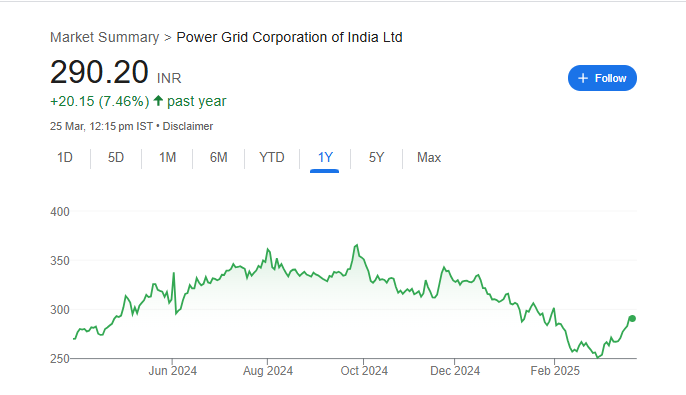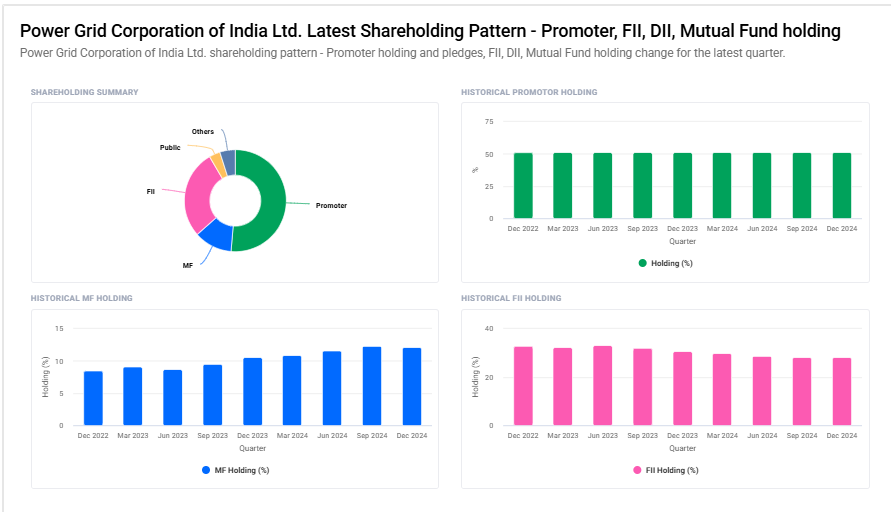Power Grid Share Price Target Tomorrow 2025 To 2030
Power Grid Corporation of India Ltd. (Power Grid) is a leading company in India’s power transmission sector. It plays a key role in managing the country’s electricity supply by operating a vast network of transmission lines. As a government-backed company, Power Grid benefits from strong financial support and stable revenue from long-term projects. The stock is considered a good option for investors looking for steady growth and dividends. Power Grid Share Price on NSE as of 25 March 2025 is 289.65 INR.
Current Market overview of Power Grid Share Price
- Open: 291.00
- High: 295.25
- Low: 289.00
- Previous Close: 291.85
- Volume: 7,804,383
- Value (Lacs): 22,597.59
- VWAP: 292.84
- Mkt Cap (Rs. Cr.): 269,298
- Face Value: 10
- UC Limit: 321.00
- LC Limit: 262.70
- 52 Week High: 366.25
- 52 Week Low: 247.30
Power Grid Share Price Target Tomorrow 2025 To 2030
| Power Grid Share Price Target Years | Power Grid Share Price |
| 2025 | INR 390 |
| 2026 | INR 420 |
| 2027 | INR 450 |
| 2028 | INR 480 |
| 2029 | INR 510 |
| 2030 | INR 540 |
Power Grid Share Price Chart

Power Grid Shareholding Pattern
- Promoter: 51.3%
- FII: 28.1%
- DII: 17%
- Public: 3.5%

Key Factors Affecting Power Grid Share Price Growth
-
Expansion of Power Infrastructure
Power Grid Corporation plays a crucial role in expanding and upgrading India’s power transmission network. Increased government investments in electricity infrastructure and rural electrification projects can drive revenue growth and positively impact the share price. -
Renewable Energy Integration
As India moves towards cleaner energy, Power Grid is responsible for integrating renewable sources like solar and wind into the national grid. More projects in this sector can boost the company’s earnings and support share price appreciation. -
Regulated Revenue Model
Power Grid operates under a regulated return model, ensuring stable cash flow and profitability. This financial stability makes the stock attractive to investors and supports long-term price growth. -
Strong Financial Performance
Consistent revenue growth, profitability, and efficient cost management can increase investor confidence. Higher earnings per share (EPS) and strong dividend payouts make the stock appealing to both retail and institutional investors. -
Government Policies and Support
Favorable government policies, such as incentives for transmission expansion and privatization of the power sector, can enhance Power Grid’s business opportunities, leading to better stock performance. -
Technological Advancements
The adoption of smart grid technology, digital monitoring systems, and automation in power transmission can improve efficiency and reduce losses. These advancements can increase operational performance, leading to higher investor confidence. -
Foreign and Domestic Investments
Increased investments from global and domestic institutions in India’s power sector can provide financial support for Power Grid’s growth. A rise in foreign direct investment (FDI) in infrastructure can also improve the company’s valuation and share price.
Risks and Challenges for Power Grid Share Price
-
Regulatory Uncertainty
Power Grid operates under government regulations, and any changes in tariff policies, licensing rules, or subsidy reductions can affect revenue. Strict regulatory oversight may limit profit growth and impact the share price. -
Dependence on Government Projects
A major portion of Power Grid’s revenue comes from government-backed projects. Any delays in approvals, funding issues, or changes in government priorities can slow down business growth and affect investor sentiment. -
High Debt Levels
Power Grid requires large investments for infrastructure development, leading to high debt. If borrowing costs rise or debt repayment becomes challenging, it could strain the company’s finances and put pressure on the stock price. -
Integration Challenges for Renewable Energy
The shift towards renewable energy requires significant transmission upgrades. If Power Grid faces technical or financial difficulties in integrating renewable sources, it may slow down growth and impact future earnings. -
Competition from Private Players
With increasing privatization in the power sector, private companies are entering the transmission business. If Power Grid loses market share to competitors, it may affect its revenue and stock performance. -
Operational Risks and Infrastructure Maintenance
Power transmission networks are vulnerable to technical failures, natural disasters, and cyberattacks. Any major disruption in operations can lead to financial losses, affecting investor confidence and share price movement. -
Fluctuations in Interest Rates and Inflation
Rising interest rates can increase borrowing costs for Power Grid, while inflation can push up operational expenses. Both factors can reduce profitability, leading to lower investor interest in the stock.
Read Also:- RCOM Share Price Target Tomorrow 2025 To 2030







